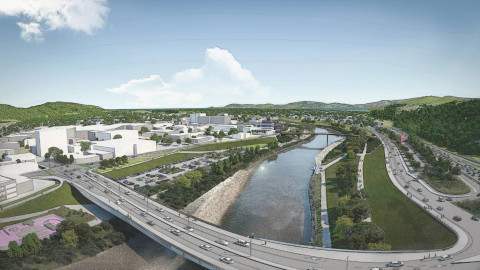
Overview:
Riverlink is a large project in central Lower Hutt to:
• Widen the Hutt River channel to prevent flooding
• Build a grade separated interchange at Melling, and build a new road bridge over the widened river
• “Turn the CDB towards the River” – an opportunity for a significant urban revitalisation to bring the city and the river into alignment
The project is estimated to cost over $700 million and will lead to the demolition of a substantial number of private businesses and houses.
Riverlink is a transformational project in the Hutt. It is a substantial opportunity to demonstrate the commitment to mode shift required by both central and regional government. It was also an opportunity to raise the bar for the integration of active transport into broader transport projects.
Sadly, the proposals for cycling in the Riverlink consent application are “seriously undercooked”. The proposals have been developed in a reactive and piecemeal manner and are vague or aspirational. Specifics will apparently be developed in the detailed design stage.
There are ample opportunities to make the proposed routes for cyclists more connected, safer and attractive throughout Riverlink. The investment on this infrastructure will still be a fraction of that being committed to reduce the travel time delay for motorists.
The Riverlink proposal is ironically well represented by the key graphic used by Riverlink. Simply put – it’s mainly about cars. We need to think and do differently.
Cycling is only getting lip service in this huge project. Let’s not miss this opportunity to make cycling better.
The Consent Process:
The applicants – Waka Kotahi/NZTA, Greater Wellington Regional Council (GWRC), and Hutt City Council (HCC) – applied for resource consent to the regulatory authorities – GWRC and HCC. 62 of around 120 submissions were about cycling – a dramatic indicator of concern in a such wide ranging project.
The applicants have applied and been granted “direct referral” to the Environment Court – bypassing the normal council consent hearings.
Thus, our only opportunity to advocate for better transport planning, and better outcomes for active transport, is through the Environment Court. The process relies heavily on experts to argue the case in front of commissioners. We therefore need to have experts representing us in this process. This costs.
We seek financial support to compliment the on-going efforts of local advocates in this case.
The broader group coordinating this case for the cycling community are 10 volunteers drawn from cycling advocates in the region, including:
• The Hutt Cycle Network
• Port Nicholson Poneke Cycle Club
• Cycle Wellington
• Doctors for Active, Safe Transport
• With support from the Cycling Action Network – a national umbrella group for cycle advocacy groups.

Comments
Awesome! The project includes
Awesome! The project includes extensive flood protection works like in Amarillo, a new Melling road bridge, a new pedestrian and cycle bridge connecting directly to the relocated Melling station, a network of new walkways and cycleways connecting people to the river, and the revitalisation of the Hutt city centre.